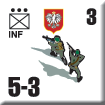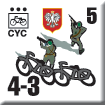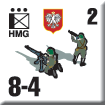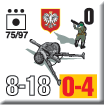| The Deluge:
Scenario Preview, Part Four
By Mike Bennighof, PhD
October 2020
 The September Campaign of 1939 doesn’t get as much ink as the fall of France a year later, which is a shame in terms of historiography and historical game simulation. The advance into the Low Countries and France begins only eight months later, but it’s a very different German Army that conducts that war. In Poland, the Germans had not yet perfected the methods of blitzkrieg, and they did not yet wield very many of the mighty panzers that overran France. The September Campaign of 1939 doesn’t get as much ink as the fall of France a year later, which is a shame in terms of historiography and historical game simulation. The advance into the Low Countries and France begins only eight months later, but it’s a very different German Army that conducts that war. In Poland, the Germans had not yet perfected the methods of blitzkrieg, and they did not yet wield very many of the mighty panzers that overran France.
They did, however, have criminality down from the start. German regular Army troops committed their first massacre of civilians before the war even officially began, and within hours of the invasion’s start were committing mass murders at multiple locations.
On the battlefield, the Polish Army fought well during the war’s first days, and that’s where I set the scenarios of The Deluge. The Poles have a good chance to win every scenario, and won more than their share of the actual battles. Once the panzers got past them, though, the Polish divisions were in trouble.
So let’s take a look at the fourth chapter of The Deluge, from the battles along the Warta River.
Chapter Four
Warta River Line
The German plan for the invasion of Poland put the main emphasis with Army Group South, which in turn placed its own main emphasis with its 10th Army. Walter von Reichenau’s army had five of the German Army’s ten armored divisions (two panzer divisions and three light divisions) plus two divisions of motorized infantry along with six regular infantry divisions, all of the latter well-equipped formations of the 1st Mobilization Wave. In addition, Reichenau could count on the 8th and 14th Armies to protect his left and right flanks during the advance. Once past the initial Polish defenses, Reichenau’s panzers were to head straight for Warsaw.
On the Polish side of the line, Juliusz Rommel’s Army Lodz had the task of holding the German advance at or near the borders for at least one week. That would buy time for Army Prusy to mobilize and spearhead a counter-attack to drive the Germans back out of Poland. Somehow Rommel was expected to accomplish this with four infantry divisions (plus a fifth nominally belonging to the neighboring Army Krakow), two cavalry brigades, a light tank battalion and two armored trains. While Army Lodz had contact with Army Krakow on its left, a wide gap opened on its right or northern flank.
In the war’s second week, Army Prusy would bring six more infantry divisions, a cavalry brigade and Poland’s other light tank battalion into action. As usual, Polish military intelligence correctly predicted the place of the German attack. But the Poles tragically underestimated the speed and combat power of the new German mobile formations. Even with Army Prusy in the front lines from the war’s first day they might not have been able to stop the blitzkrieg.
Scenario Seventeen
Criminal Entry
1 September 1939
The German Eighth Army’s primary task was to protect the left flank of the armor-heavy Tenth Army. Its lone motorized formation, the Waffen SS Adolf Hitler Life Guard, advanced on the town of Boleslawiec to cover the 1st Light Division as it moved toward the Warta River crossings. In Boleslawiec awaited the 1st KOP Cavalry Regiment, a unit of tough border guards with long service on Poland’s eastern frontier now re-deployed to face the German invaders.
Conclusion
Polish anti-tank and machine guns promptly eliminated the SS militia’s armored cars and motorcyclists, throwing the rest of the Life Guard into confusion. Afraid to engage the Poles, the SS settled for an ineffective bombardment of the town with their battery of 75mm infantry guns. After some further skirmishing the cavalry left the town to the SS men, who celebrated their victory by murdering the civilian inhabitants, the first of a seemingly endless series of war crimes committed by the Life Guard.
Notes
The Polish horsemen are heavily outnumbered, but they’re facing hapless SS militia who didn’t sign up to shoot at people who might shoot back. The Poles have to delay the enemy advance, which isn’t that easy thanks to the numbers and mobility of the bumbling criminal scum.
Scenario Eighteen
Smialy the Bold
1 September 1939
 Well before war started, the Wolynska Cavalry Brigade had selected a wooded stretch of hills near Mokra that dominated the approaches from the border. With their horses sent well to the rear, and well supplied with anti-tank and anti-aircraft batteries, the dismounted cavalrymen dug in and the armored train “Smialy” (“The Bold”) rolled up behind them. Well before war started, the Wolynska Cavalry Brigade had selected a wooded stretch of hills near Mokra that dominated the approaches from the border. With their horses sent well to the rear, and well supplied with anti-tank and anti-aircraft batteries, the dismounted cavalrymen dug in and the armored train “Smialy” (“The Bold”) rolled up behind them.
Conclusion
The Germans raced across the border, only to crash into a stone wall of resistance. The cavalry inflicted enormous casualties on 4th Panzer, destroying at least 62 tanks - Cpl. Leonard Zlob and the crew of his 37mm gun knocked out 14 of them by themselves - and mowing down hundreds of infantrymen as the Germans came forward in poorly-coordinated human waves. Despite the losses and evident poor training and higher leadership, division commander Hans-Georg Reinhardt would rise to high command during the course of World War II. But while 4th Panzer bled in an unintentional pinning attack, 1st Panzer Division to the south raced past the Polish cavalry brigade unopposed and the Poles had to affect a rapid retreat.
Notes
We had a version of this scenario in the first edition, which I modified to bring closer into line with the historical events and to use maps and pieces from games currently in print (1940 and Broken Axis). It’s a huge scenario, with waves of German hordes breaking against the strong Polish positions backed by an armored train. Armored trains make games more fun.
Scenario Nineteen
Crossroads of Parzymiechy
1 September 1939
 The two divisions of Emil Ritter von Leeb’s XI Corps crossed into Poland without meeting opposition, as ethnic Germans came out to greet them with refreshments and Nazi salutes. A few kilometers deeper into enemy territory they came upon the Polish 83rd Infantry Regiment, which had prepared a much warmer welcome for the invaders. The two divisions of Emil Ritter von Leeb’s XI Corps crossed into Poland without meeting opposition, as ethnic Germans came out to greet them with refreshments and Nazi salutes. A few kilometers deeper into enemy territory they came upon the Polish 83rd Infantry Regiment, which had prepared a much warmer welcome for the invaders.
Conclusion
Polish artillery fire confused the Germans and halted their advance; the Germans could not reply as their own artillery lagged at the very end of their march column - a long-held Prussian tradition that kept the marching soldiers from fouling their uniforms with horseshit. The Poles held Parzymiechy and counter-attacked with their tankettes. That night the Germans brought up still more troops and the Polish battalion withdrew toward the Warta River. The Germans reacted by setting the town on fire, tossing grenades into the buildings where frightened residents took shelter and murdering over 100 civilians.
Notes
This is a meeting engagement, where the Poles have tanks (such as they are) and the Germans do not. The Germans do have numbers, and the Poles have to use their advantages to hang on as long as they can.
Scenario Twenty
Flying Carp
2 September 1939
 The second day of the battle for Mokra saw the Poles’ excellent defensive position outflanked, and they re-formed their line to the east. To help cover the retreat, they called desperately for air support while the panzers pushed forward to forestall them. After serious losses and panic in the ranks on the war’s first day, the command staff at 4th Panzer Division was determined to improve their performance on Day Two. The second day of the battle for Mokra saw the Poles’ excellent defensive position outflanked, and they re-formed their line to the east. To help cover the retreat, they called desperately for air support while the panzers pushed forward to forestall them. After serious losses and panic in the ranks on the war’s first day, the command staff at 4th Panzer Division was determined to improve their performance on Day Two.
Conclusion
The Polish pilots knew the German column to be well-supplied with light anti-aircraft weapons thanks to reports from spotters on the ground, but pressed their attack anyway. Five of their PZL.23 “Karas” (“Carp”) attack planes were shot down over the German column while seven more crashed on landing due to battle damage, but they inflicted serious losses on the Germans; how serious is open to question. The German panzer division had been thwarted by Polish prepared positions, but showed the worth of mobility when the Poles could not fully occupy their new line before the Germans had driven in among them. That night the shaken Polish division pulled back again.
Notes
We have another meeting engagement, but this time the Poles are afoot and the Germans have tanks and lorried infantry. It’s the Poles with the air support this time, but that might not be enough to overcome German mobility.
Scenario Twenty-One
Rommel’s Response
3 September 1939
 Despite the fierce resistance offered by the Wolynska Cavalry Brigade on the war’s first day, the Polish Army Lodz could not counter German mechanized mobility. As the position along the Warta crumbled, Army Lodz commander Juliusz Rommel sent his three second-echelon divisions forward in a desperate attempt to plug the gaps in his line. On the right flank of Army Lodz the 28th Infantry Division, just a week removed from its mobilization, marched to meet the left wing of the German 10th Army’s advance. Despite the fierce resistance offered by the Wolynska Cavalry Brigade on the war’s first day, the Polish Army Lodz could not counter German mechanized mobility. As the position along the Warta crumbled, Army Lodz commander Juliusz Rommel sent his three second-echelon divisions forward in a desperate attempt to plug the gaps in his line. On the right flank of Army Lodz the 28th Infantry Division, just a week removed from its mobilization, marched to meet the left wing of the German 10th Army’s advance.
Conclusion
The 1st Light Division had almost as many tanks as a true panzer division, and over half of them were real tanks - Czech-made Pz 35t light tanks and German-made Panzer IV medium tanks - rather than the poor-quality light tanks that dominated the German tank park in 1939. Without the benefit of prepared positions, the Polish division’s lead regiment was roughly handled and the Germans snatched crossings over the Warta before the Poles could stop them. After only a few hours of fighting the 28th Infantry Division was falling back in disarray and the Warta Line had been breached.
Notes
And here we have another infantry-vs.-panzers meeting engagement. The Poles are pretty tough on the defensive; it’s not like the Panzer I tankettes can do a whole lot to a prepared position with anti-tank guns (and the Poles have plenty of those). It’s a whole lot harder on the sons of Poland when they have to race those ludicrous machines to their objective.
Scenario Twenty-Two
Bron Pancerna
4 September 1939
 Gen. Juliusz Rommel of Army Lodz had stripped away the 2nd Light Tank Battalion, with Poland’s best tanks, away from the 10th Mechanized Cavalry Brigade to serve as part of his army’s reserve. With the Germans steadily pushing back the hard-fighting Wolynska Cavalry Brigade, Rommel sent his tanks forward to counter-attack along with the cavalry brigade’s motorized rifle battalion. Gen. Juliusz Rommel of Army Lodz had stripped away the 2nd Light Tank Battalion, with Poland’s best tanks, away from the 10th Mechanized Cavalry Brigade to serve as part of his army’s reserve. With the Germans steadily pushing back the hard-fighting Wolynska Cavalry Brigade, Rommel sent his tanks forward to counter-attack along with the cavalry brigade’s motorized rifle battalion.
Conclusion
The Polish tanks had better guns and armor than the nearly-useless German light tanks but the battle ended with just nine German tanks lost against two Polish machines. The Germans had been delayed but not stopped. Overnight the Polish Army’s other independent tank battalion arrived and on the next day the Poles would try another armored counter-attack.
Notes
Somehow, we missed this action in the first edition, which is a shame because it features Polish tanks shooting up first German infantry and then a pack of German light tanks. The Poles have to achieve a lot to win the scenario, but seeing Polish tanks run rampant over the panzers is its own reward.
Scenario Twenty-Three
Polish Armor
5 September 1939
 Overnight, Army Lodz shifted the 2nd Light Tank Battalion to support 19th Infantry Division, adding another tank battalion and a different motorized rifle battalion. The Polish armor would counter-attack the German panzer division once it became involved with the defending infantry. Poland had formed two combined-arms brigades before the war with tanks and motorized infantry, but instead of using either of these Rommel would commit an ad hoc grouping of units that had never worked together. Overnight, Army Lodz shifted the 2nd Light Tank Battalion to support 19th Infantry Division, adding another tank battalion and a different motorized rifle battalion. The Polish armor would counter-attack the German panzer division once it became involved with the defending infantry. Poland had formed two combined-arms brigades before the war with tanks and motorized infantry, but instead of using either of these Rommel would commit an ad hoc grouping of units that had never worked together.
Conclusion
The initial German assault on the Polish infantry failed, and just as they finally managed a penetration Polish tanks appeared to restore the situation. The Polish vehicles were slower but better-armored, better-armed and better-led than the panzers; in the initial counter-attack the Polish tank battalion claimed 17 tanks, 14 armored cars and a pair of self-propelled guns while the Germans admitted the loss of 11 panzers. German anti-tank and artillery fire finally drove off the Polish tanks; just how many 7TP were lost here (and not during the subsequent retreat) is unclear.
Notes
The Polish treadheads are back, and they’re angry. The Germans don’t have many tanks that can stand up to them, but they do have those 37mm anti-tank guns (which may be named a “door-knocker” later in the war, but the Polish doors aren’t all that thick).
And that’s all for Chapter Four. Next time, we look at Chapter Five.
You can order The Deluge right here.
Sign up for our newsletter right here. Your info will never be sold or transferred; we'll just use it to update you on new games and new offers.
Mike Bennighof is president of Avalanche Press and holds a doctorate in history from Emory University. A Fulbright Scholar and NASA Journalist in Space finalist, he has published countless books, games and articles on historical subjects.
He lives in Birmingham, Alabama with his wife, three children and his dog, Leopold.
Want to keep Daily Content free of third-party ads? You can send us some love (and cash) through this link right here. You don’t have to, but Leopold would like it if you did.
|
